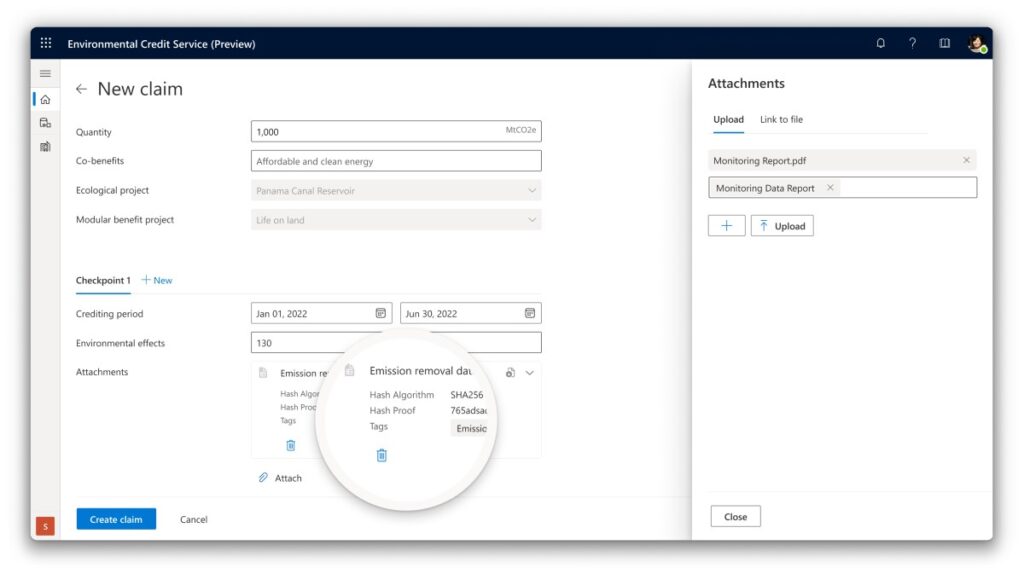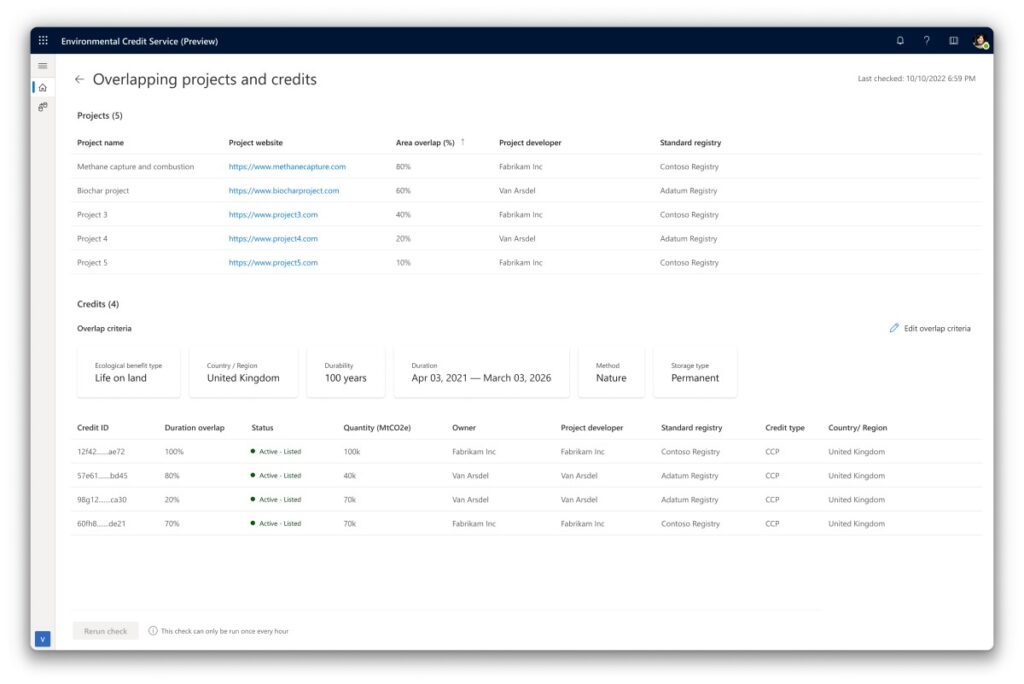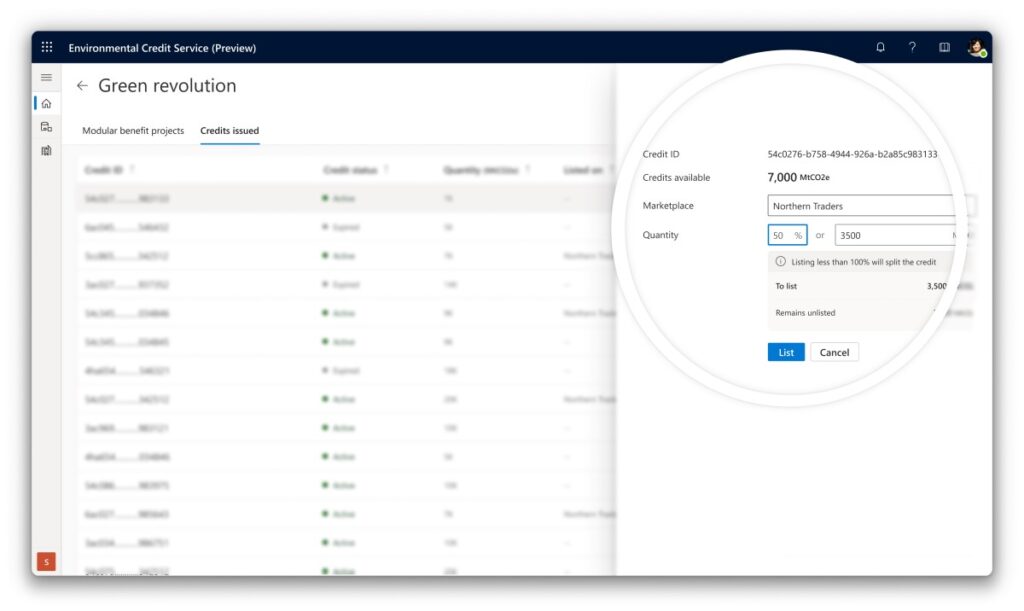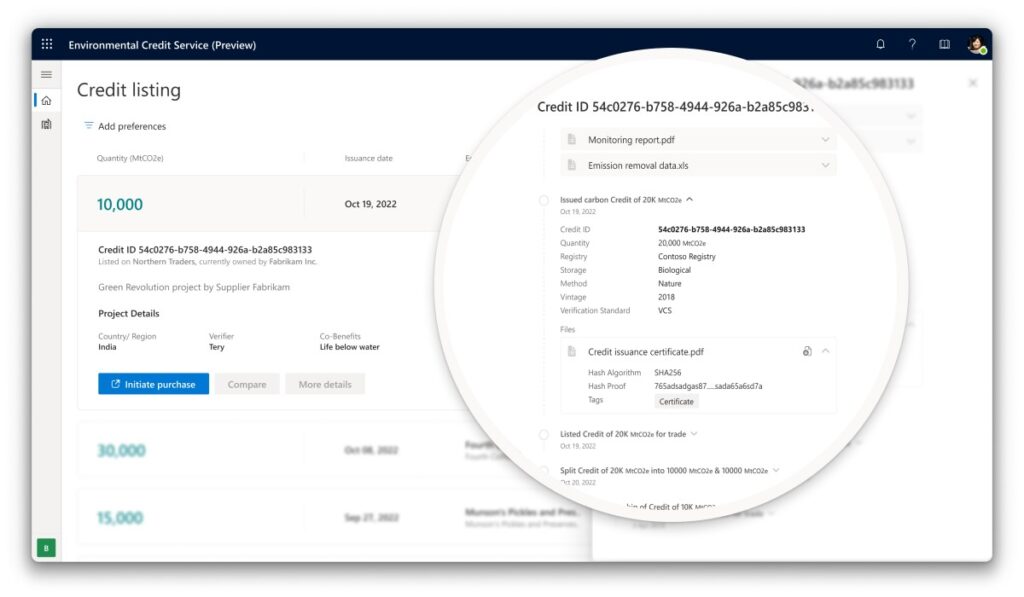
Increasing transparency for carbon credits with Environmental Credit Service
Carbon credit enthusiasts, take heart. More and higher-quality environmental assets are soon to hit the market.
Thanks to growing awareness about the transformational steps1 that are needed to achieve global net zero, organizations are increasingly focused on reducing emissions as much as possible and neutralizing what they can’t abate. Many are turning to emergent carbon offset markets, both voluntary and compliance-driven, to invest in verified, comparable, and tradable CO2 reduction and removal credits. These and other environmental assets have shown encouraging potential—with up to 15 times demand growth projected by 20302—but also setbacks, such as inconsistent quality standards, siloed credit registries, and inefficient processes.
Today we’re announcing Environmental Credit Service (preview), a Microsoft Cloud for Sustainability solution, delivering a common infrastructure to begin addressing these setbacks by improving transparency and the ability to track provenance through the credit creation process.
“Carbon credits are a crucial market-based mechanism to finance solutions for climate mitigation. But to realize its true potential, we need a healthy carbon services ecosystem underpinned by trust.”—Mikkel Larsen, Chief Executive Officer, Climate Impact X
With the new service, environmental assets can be traced from origination to retirement. This increased visibility into the provenance and quality of environmental claims and credits, based on existing and emerging quality standards, enables a higher volume of more reliable credits and assets—expanding options and opportunities for environmental project developers as well as downstream participants like verifiers, registries, and marketplace or exchanges. Environmental Credit Service benefits all parties by automating, simplifying, and helping to secure the credit origination process.
To learn more, download the infographic or listen to a conversation about the service.
Environmental Credit Service
Redefining environmental assets with transparency.

Building a common infrastructure based on our own lessons learned
In our decade-plus of working to become more sustainable, focusing on carbon reduction and removal and other key focus areas, Microsoft’s team of environmental and data scientists has uncovered the systemic challenges of determining the quality and integrity of environmental products and carbon removal projects.
We know that the world lacks a consistent set of standards for measuring, verifying, and reporting (MRV) carbon reduction and removal. Removals are sometimes mixed up with offsets that obscure avoided or reduced emissions, and different credit systems place different values on assumed durability of solutions.
Without common standards, corporate credit purchasers end up bearing the burden of due diligence. They’re often left to develop their own criteria, hindering confidence in investments as well as the ability to track outcomes as they do their work in isolation.
Meanwhile, environmental project owners (and developers), verifiers, and registries who are seeking to create, process, and issue credits based on evidence-backed claims are left to navigate processes that are complicated, time-consuming, and expensive.
On a whole, the asset lifecycle process is prone to inefficiency and inconsistency in claims, and participants face specific drawbacks like:
- Excessive time and cost of initiating credit-generating environmental projects.
- Siloed credit creation in registries that lack the technology to streamline and automate the origination process.
- Difficulty evaluating issued credits for quality or comparing them across supply silos.
- Lack of trust in credits’ provenance due to lack of data transparency.
- Time wasted on developing non-differentiated technical plumbing instead of differentiated offerings based on updated, digitized quality standards.
“Business as usual is no longer an option. We need partnerships across sectors where we can benefit from our combined strengths and capabilities, because collaboration, trust, and above all, action, is what will make us successful in reaching our global climate targets.”—Hanne Rolén, Head of Sustainability, Aker Carbon Capture
Our engineering journey to redefine the environmental product lifecycle
As an engineering team, we set out to work with our customers and partners, including our own internal carbon team, to see if there was something we could do to help address these issues. Environmental Credit Service is a first step in delivering a common infrastructure and shared data standard to drive the environmental crediting process and collect the data needed for the differentiation of products.
With it, we’ve redefined environmental product origination following open standards that we helped develop with the InterWork Alliance (IWA), an initiative of the Global Blockchain Business Council (GBBC), to simplify how the voluntary environmental market lifecycle works.
Our efforts aim to:
- Increase the supply of carbon credit, reduction, and removal projects from a diverse global ecosystem of projects while adding trust and credibility.
- Decrease the cost of creating these credits by automating and digitizing the lifecycle to lower financial barriers to bringing these credits to market.
- Speed the time to market and incentives to produce credits.
- Ensure the quality of credits by using data standards to allow credits from different sources and methods to easily be understood, compared, sorted, and priced, leading toward market liquidity.
“The collaboration between Microsoft and Climate Impact X builds on our ongoing efforts to bring credibility to market and will go further in connecting ecosystem players and new market entrants—ultimately helping to scale the global carbon markets.”—Mikkel Larsen, Chief Executive Officer, Climate Impact X
Voluntary carbon credit origination with Environmental Credit Service
Here’s what the credit origination process looks like when using the service to trace provenance for carbon removal, as an example:
- Stakeholders seamlessly connect to the network following a one-time role-based setup, which allows them to engage in their role’s activities in the lifecycle.
- Project developers establish their project details, then select a quality standard and a certified verifier to establish the supply chain for their credits on the network.
- The project begins to collect evidence based on the quality standard, measuring carbon captured as well as emitted during the process of capturing it. This evidence is submitted periodically as a checkpoint for their claim of carbon removal.

- The claim is built throughout the carbon removal activity, with evidence being cryptographically secured so that its provenance and authenticity are guaranteed. Once the carbon removal activity is complete, the claim is automatically submitted for verification on the network and picked up by their verifier for processing.
- The verifier locks the submitted claim so that no other verifier will be able to process it. The framework then provides all the evidence, with its chain of custody and authenticity automatically established, to the verifier for the data to be processed. Once validation and verification are complete, the verifier creates a processed claim, and the originally submitted claim is retired and cannot be verified again.
- The processed claim provides a detailed report as to the total quantity of carbon removed, along with all the attributes or properties that differentiate the processed claim. For example, the processed claim will include properties for the total amount of carbon removed and the durability of the removal, indicating the term of sequestration, risk of reversal as well as how any reversal is mitigated. Other properties may include co-benefits that would map to goals such as the United Nations Sustainable Development Goals.

- The issuing registry is automatically notified of the processed claim and begins the final quality and compliance checks for the credit to be issued. Once complete, the carbon removal credit is issued to the project and the processed claim is retired, preventing it from being credited more than once.
- After issuance, the project owner can choose where and how to distribute the credit—for example, as a single asset for sale in a marketplace, bundled into a basket of assets for larger-volume purchases, or broken into smaller assets that can be used for micro-transactions or as asset attachments.

- Marketplaces can leverage the credit provenance capability of Environmental Credit Service to establish trust with buyers regarding credits being transacted.

- Marketplaces (or credit purchasers with registry accounts) can facilitate whole or partial retirement of credits. Retirement proposals can be submitted to registries, which can issue retirement certificates.
A future of opportunity for lifecycle participants
Under Article 6 of the Paris Agreement, voluntary and compliance markets will soon be allowed to work together and voluntary actions will be allowed to count toward regulatory compliance for emissions at the country level. Environmental Credit Service offers a timely solution for market participants, supporting the confluence of environmental markets and the acceleration of projects—and a plethora of opportunities.
Participants in different roles can, for example, quickly create reduction or removal claims via automation or expand renewable energy credits (RECs) to include bundled benefits. They can deliver data-driven services using verified reference data (such as IoT and satellite data) that can be shared via common models and analyzed in the cloud. They can track claim and verification anomalies using AI—and much more. Early deployments of the service will help inform and enable these efforts.
One pilot by Verra, the manager of the world’s leading greenhouse gas crediting program, integrates Environmental Credit Service with Microsoft Planetary Computer and Muon Space satellite technology to automate the remote monitoring of land-based environmental projects, enabling more accurate quantifying of net emission reductions.
“This remote monitoring system is a first and important step toward digitizing the measurement, reporting, and verification process and ensuring the issuance of high-integrity carbon credits.”—Benktesh Sharma, Senior Director of Technology Solutions, Verra
Puro.earth, the world’s first carbon crediting platform focused solely on engineered carbon removal, worked alongside Nasdaq, Inc. and Microsoft to expand the accessibility of its Puro Standard verified carbon removal credits. Environmental Credit Service will help organizations more efficiently discover and increase their use of Puro.earth credits.
Nasdaq, Inc., for its part, has provided input on the development of Environmental Credit Service regarding technology, standard protocols, and functionalities. The company aims to improve liquidity, transparency, and integrity in the carbon removal market and support its own clients on their path to net zero.
“The pilot transactions with Microsoft and other carbon market participants emphasize the critical role of collaboration in meeting the rising demand for reliable and traceable carbon credits so the markets can fulfill their potential as a key driver of climate action.”—Robin Green, Executive Director, Digital Markets, CIBC Capital Markets and CIBC representative for Carbonplace
Carbonplace, a global carbon credit transaction network, will use the service to enable simple, transparent transfer of certified carbon credits. By combining its existing compliance frameworks with innovative blockchain-enabled distributed ledger technology, Carbonplace will open carbon credit investment to a broad spectrum of purchasers.
SustainCERT, a technology-driven verification organization that helps businesses and investors efficiently and credibly quantify the impacts of sustainability and carbon crediting programs, is exploring how Environmental Credit Service can help standardize data for better interoperability between its platform and third-party platforms.
Ørsted, a developer of offshore and onshore renewable energy facilities, cooperated with Microsoft and Aker Carbon Capture on carbon capture and storage for biomass-fired heat and power stations, also known as BECCS. Using Environmental Credit Service, the partnership can help mature and develop the voluntary carbon market while providing high-quality carbon removal.
“Ørsted expects this project and the Microsoft collaboration to provide a vantage point for the deployment of BECCS, digital solutions, and carbon credit methodologies across Ørsted’s asset portfolio and potentially become a blueprint for BECCS projects across the power sector in general.”—Jens Andersen Grymer, Vice President, Ørsted
Join our quest to build a more sustainable world
Our mission at Microsoft is to empower every person and organization on the planet to achieve more—to thrive and develop past today’s limits. We believe that addressing the climate crisis requires all organizations and governments to collaborate and share information to build collective solutions, faster.
With Microsoft Cloud for Sustainability solutions, we’re equipping organizations to accelerate sustainability progress and business growth by bringing together a growing set of environmental, social, and governance (ESG) capabilities from Microsoft and our global ecosystem of partners.
Stay up to date with Microsoft Cloud for Sustainability news and updates.
To preview Environmental Credit Service, please submit a request.
Microsoft Cloud for Sustainability
Record, report, and reduce your environmental impact with Microsoft Sustainability Manager—a new Microsoft Cloud for Sustainability solution that’s now available.

1The evidence is clear: the time for action is now. We can halve emissions by 2030. IPCC




